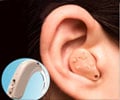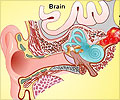Clinical characteristics of tinnitus such as duration, consistency and other factors influence the way individuals perceive loudness and annoyance associated with the condition.
Clinical characteristics of tinnitus such as duration, consistency and other factors influence the way individuals perceive loudness and annoyance associated with the condition, according to a report.
Tinnitus, a ringing, buzzing or whistling sound in one or both ears occurring without outside stimulus, can be acute or chronic, constant or intermittent. Tinnitus can be due to a medical disease or of unknown origin. According to background information in the article, some patients describe their tinnitus to be louder than most or all environmental sounds and 1 percent to 5 percent report that tinnitus is so troublesome that it interferes with sleep or has led to disability and reduced quality of life.Wolfgang Hiller, Ph.D., University of Mainz, Germany, and Gerhard Goebel, M.D., from Roseneck Center of Behavioral Medicine, Prien, Germany, analyzed data from a mail survey composed of two parts: a questionnaire to assess perceived annoyance and a comprehensive screening questionnaire that grades loudness. The total of 4,995 individuals who responded had an average age of 56 years and was 42 percent female and 58 percent male.
A total of 4,971 individuals accurately completed the loudness survey. Of these, 407 (8.2 percent) rated their condition as grade I (weak degree of tinnitus loudness), 2,964 (59.6 percent) as grade II (medium degree of tinnitus loudness) and 1,600 (32.2 percent) as grade III (strong degree of tinnitus loudness). Annoyance scores were available for 4,982 people of whom 1,957 (39.2 percent) were categorized as mildly distressed, 1,189 (23.9 percent) as severely distressed and 637 (12.8 percent) as most severely distressed. Most of those with grade I conditions reported mild tinnitus distress, those with grade II conditions were split and approximately two-thirds of those in grade III reported having severe or very severe distress, indicating a moderate correlation between loudness and annoyance.
“In particular, higher levels of severity were found in men, older adults, binaural [in both ears] and centrally perceived tinnitus, increase in tinnitus intensity since onset, sensitivity to loud external noise, continuous tinnitus (as opposed to intermittent tinnitus) and the coexistence of hearing loss, vertigo and hyperacusis [abnormal sensitivity to sounds],” the authors note. However, other factors had an inconsistent influence on loudness and annoyance. The share of individuals who experienced an increase in tinnitus loudness since onset was 35 percent whereas there was no clear increase in tinnitus annoyance in years since onset. The authors believe it is possible that habituation and acceptance of tinnitus increase over time, which is likely to lead to reduced annoyance.
“Although it has been shown that personal distress due to tinnitus is to some degree dependent on primarily psychological factors such as cognitive appraisal or differences in coping behavior, the role of physical, audiologic and medical properties of tinnitus should not be underestimated,” the authors conclude. “We need studies that investigate the determinants of tinnitus loudness and annoyance to understand more deeply how patients react to their tinnitus and which factors contribute to the long-term maintenance of distress.”
Source-Newswise
SRM











